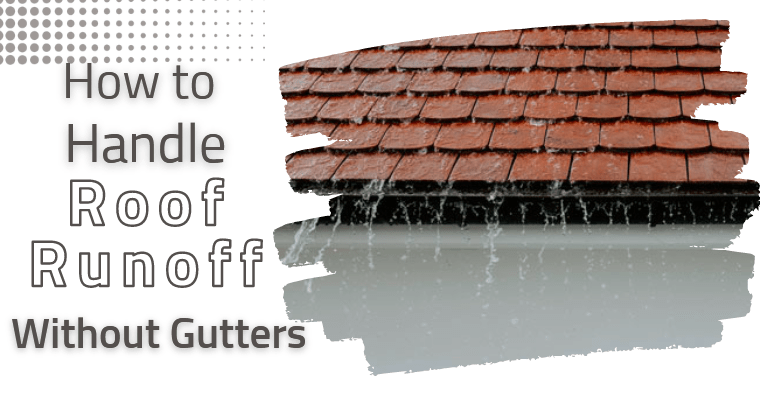Improperly managed water runoff can pool around a building’s foundation, increasing the risk of water damage. It is crucial to implement effective measures to handle roof runoff, such as installing guttering systems, even if they are not traditional. However, other effective methods exist to handle roof runoff, even without gutters.
Here, we’ll discuss some practical solutions to manage and redirect rainwater, ensuring your property remains protected from potential damage. One such method is the use of drip edges, which can be installed along the roofline to direct water away from the fascia and into a drainage system.
How to Handle Roof Runoff Without Gutters
While gutters are unnecessary for every building, they are vital in managing roof runoff and protecting the structure and its surroundings. Gutters effectively collect rainwater and direct it away from the building’s foundation, preventing potential damage and other issues.

But in some cases, gutters can be replaced, or alternatives can be used to manage roof runoff. Here are a few options:
● Rain Chains
For a more aesthetic approach, you can install a rain chain. Rain chains are visually pleasing and functional in guiding rainwater from the roof to the ground in a controlled manner.
Swap regular downspouts with rain chains made of durable materials such as aluminum, plastic, or galvanized steel. These chains slow the water flow to prevent excessive momentum. Hang them from the roof corner over a splash block or water barrel.
● Grading Adjustment
While building codes mandate that the ground around a foundation slopes away from the home, this often presupposes the presence of gutters. Adjusting the grading slope helps water drain more efficiently, which prevents water from backing up against the foundation.
● French Drains
To effectively manage roof runoff, dig a trench filled with gravel and a perforated pipe wrapped in landscaping fabric. This setup allows rainwater to soak in and flow into the drain, preventing water buildup near the foundation.
● Channel Drains
A channel drain has a channel and grate embedded in concrete, and it can fix roof runoff on concrete. The channel moves water away from the house, and the grate lets water through while keeping debris out.
● Louvered Diffusers
Louvered diffusers on fascia boards diffuse rain into smaller droplets. This helps prevent erosion and allows the ground to absorb water slowly, avoiding excessive flow and ditch formation.
● Rain Diverters
A roof runoff diverter, usually known as a rain diverter mounted on the roof, catches and redirects the runoff away from the roof edge. It is installed under shingles and helps divert water in the desired direction.
Read also: Install a Metal Roof over Shingles Furring Strips
● Temporary Solution: Builder’s Plastic
For a temporary solution, until gutters are installed, you can use 6mm thick builder’s plastic placed directly under the runoff. This absorbs the impact of falling water and prevents erosion. It’s not a permanent fix but a good temporary solution.
How Do You Reduce Roof Runoff?
Managing roof runoff is essential to prevent damage, erosion, and flooding around your property. You can mitigate these risks and contribute to sustainable water management by implementing effective strategies. Here are some helpful and sustainable tips:
- Move downspouts away from the foundation to avoid water pooling. Make sure to discharge onto a slope or designated drainage system.
- Collect rainwater in a barrel to save water and easily water plants or gardens.
- Consider planting a rain garden. Make a small garden with native plants to soak up rainwater from the roof, which helps reduce runoff and refill the groundwater.
- Plant trees near the roof to reduce groundwater by intercepting and absorbing rainfall.
- Use permeable pavement instead of concrete or asphalt to let the water soak in instead of flowing off. This helps prevent runoff and supports groundwater recharge.
- Add plants to your roof to absorb rain, reduce runoff, and insulate your home.
To further enhance roof runoff management, consider installing a drip path. This feature directly directs water flow from the roof edge into a planned drainage area, effectively reducing the risk of erosion and water damage around the structure.
How to Choose the Best Way to Divert Water from House?
So, what is the best way to redirect water from your property? Choosing the best way to divert water from your house requires considering several factors. Here’s a guide to help you make an informed decision:
- Assess your specific needs and landscape.
- Consider factors like roof size, soil type, and drainage patterns.
- Consult with professionals for expert advice.
- Evaluate options such as gutters, grading, French drains, rain diverters, etc.
- Prioritize effectiveness, cost, and maintenance requirements.
- Select a combination of solutions that suit your situation best.
Additionally, installing a French drain system can be a more sophisticated approach. Install a French drain by creating a gravel-filled trench with a perforated pipe, which helps guide the water away from the house, thereby reducing the risk of damage to your home.
With proper planning and implementation, you can successfully handle roof runoff, even without traditional gutters. This guide can be a solution for choosing the best option to handle roof runoff without gutters.


